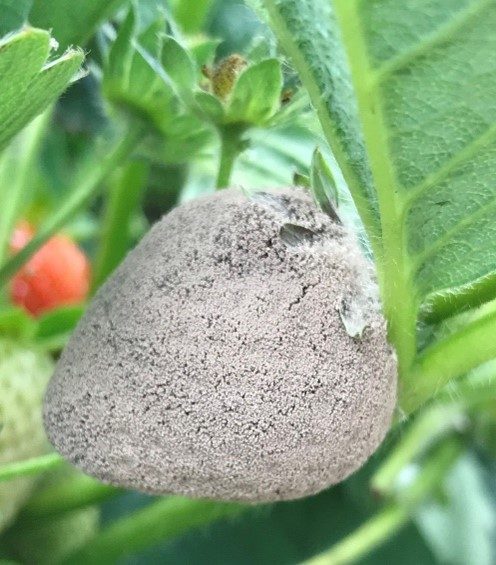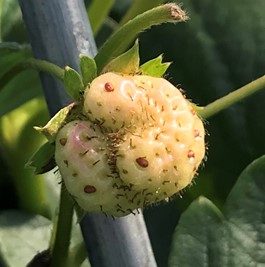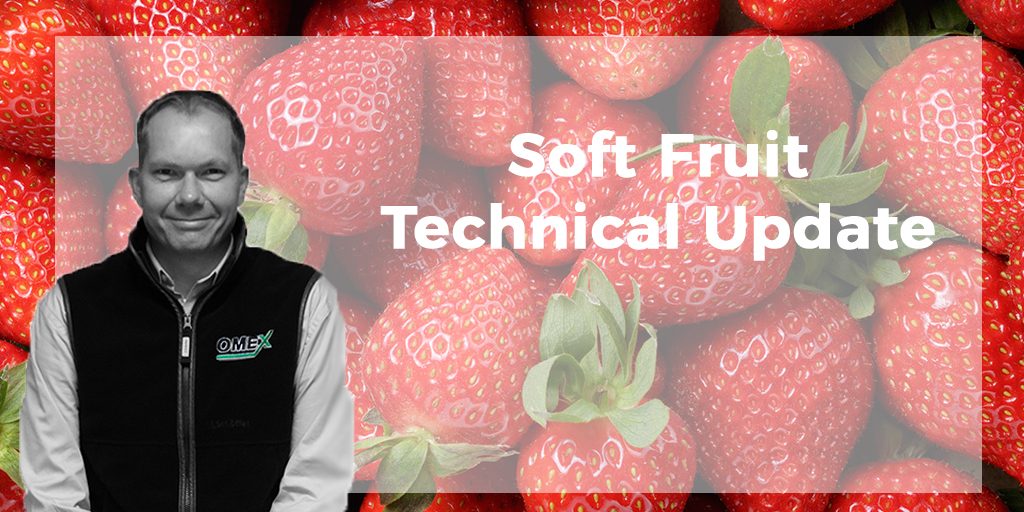Soft Fruit Agronomist, Dr Neil Holmes, gives an autumn strawberry update in the latest of our soft fruit blogs below:
As strawberry crops approach the autumn season, several challenges remain for late 60-day June bearer and ever bearer crops.
Inclement weather over recent weeks has increased the chances of botrytis and rots developing on the fruits. By the time grey mould has developed on the fruit, there is little that can be done to protect that fruit but it can be removed from the field to prevent infection of later developing fruits. Therefore, pick hard and tight to remove affected fruit and take it away from the field. Dropping affected fruits on the ground perpetuates the disease(s) within a plantation.
 strawberry botrytis
Similarly, powdery mildew has also become more evident in recent weeks on strawberries. Where appropriate, apply a plant protection product as recommended by a BASIS qualified advisor to inhibit or suppress the disease’s development.
In addition to the cultural and chemical management practices mentioned above, consider feeding with the optimal nutrition so that the crop is in the best position to deal with a disease. Zynergy contains copper and zinc which respectively strengthens cell walls and enables enzymic reactions within plants as part of their own defence response. Zynergy should always be applied with NA13, an adjuvant wetter to improve plant uptake unless it is applied in a tank mix with a pesticide.
Growers with current crops or those planning to harvest under glass this autumn should look out for boron deficiency exhibited by misshapen fruits. Poor pollination can also result in deformed fruits, so check the feed recipe and corresponding drip-in and drip-out analyses to ensure adequate boron levels are being applied to the crop. For slight deficiencies consider treating with CalMax Ultra which contains 730 mg/L of boron but for more severe deficiency symptoms apply Folex B which contains 150,000 mg/L of boron.
strawberry botrytis
Similarly, powdery mildew has also become more evident in recent weeks on strawberries. Where appropriate, apply a plant protection product as recommended by a BASIS qualified advisor to inhibit or suppress the disease’s development.
In addition to the cultural and chemical management practices mentioned above, consider feeding with the optimal nutrition so that the crop is in the best position to deal with a disease. Zynergy contains copper and zinc which respectively strengthens cell walls and enables enzymic reactions within plants as part of their own defence response. Zynergy should always be applied with NA13, an adjuvant wetter to improve plant uptake unless it is applied in a tank mix with a pesticide.
Growers with current crops or those planning to harvest under glass this autumn should look out for boron deficiency exhibited by misshapen fruits. Poor pollination can also result in deformed fruits, so check the feed recipe and corresponding drip-in and drip-out analyses to ensure adequate boron levels are being applied to the crop. For slight deficiencies consider treating with CalMax Ultra which contains 730 mg/L of boron but for more severe deficiency symptoms apply Folex B which contains 150,000 mg/L of boron.
 boron deficiency causing deformed fruit
As the autumn equinox approaches, June bearers are going through firstly, flower induction and secondly, flower initiation. Each variety has different photoperiod and temperature requirements so the exact timing of flower initiation can be determined by repeated flower mapping of the same plantation. Research has shown that reducing nitrogen inputs in August/September causes earlier flower induction (J. Carew, pers. comm. 2015). However, boosting nitrogen nutrition during flower initiation increased the number of inflorescences compared to a control where nitrogen was not increased in the June bearer “Korona” (Sønsteby et al., 2009). Whilst reducing nutrition is appropriate at this time of year, do not do it so severely as to impact on the plant’s ability to survive or cause damage to the plant’s root system.
For more information on any of the above issues, please contact your regional OMEX horticultural advisor.
Reference:
Sønsteby, A., Opstad, N., Myrheim, U. & Heide, O.M. (2009) Interaction of short day and timing of nitrogen fertilization on growth and flowering of ‘Korona’ strawberry. Scientia Horticulturae 123(2):204-209.
boron deficiency causing deformed fruit
As the autumn equinox approaches, June bearers are going through firstly, flower induction and secondly, flower initiation. Each variety has different photoperiod and temperature requirements so the exact timing of flower initiation can be determined by repeated flower mapping of the same plantation. Research has shown that reducing nitrogen inputs in August/September causes earlier flower induction (J. Carew, pers. comm. 2015). However, boosting nitrogen nutrition during flower initiation increased the number of inflorescences compared to a control where nitrogen was not increased in the June bearer “Korona” (Sønsteby et al., 2009). Whilst reducing nutrition is appropriate at this time of year, do not do it so severely as to impact on the plant’s ability to survive or cause damage to the plant’s root system.
For more information on any of the above issues, please contact your regional OMEX horticultural advisor.
Reference:
Sønsteby, A., Opstad, N., Myrheim, U. & Heide, O.M. (2009) Interaction of short day and timing of nitrogen fertilization on growth and flowering of ‘Korona’ strawberry. Scientia Horticulturae 123(2):204-209.
 strawberry botrytis
Similarly, powdery mildew has also become more evident in recent weeks on strawberries. Where appropriate, apply a plant protection product as recommended by a BASIS qualified advisor to inhibit or suppress the disease’s development.
In addition to the cultural and chemical management practices mentioned above, consider feeding with the optimal nutrition so that the crop is in the best position to deal with a disease. Zynergy contains copper and zinc which respectively strengthens cell walls and enables enzymic reactions within plants as part of their own defence response. Zynergy should always be applied with NA13, an adjuvant wetter to improve plant uptake unless it is applied in a tank mix with a pesticide.
Growers with current crops or those planning to harvest under glass this autumn should look out for boron deficiency exhibited by misshapen fruits. Poor pollination can also result in deformed fruits, so check the feed recipe and corresponding drip-in and drip-out analyses to ensure adequate boron levels are being applied to the crop. For slight deficiencies consider treating with CalMax Ultra which contains 730 mg/L of boron but for more severe deficiency symptoms apply Folex B which contains 150,000 mg/L of boron.
strawberry botrytis
Similarly, powdery mildew has also become more evident in recent weeks on strawberries. Where appropriate, apply a plant protection product as recommended by a BASIS qualified advisor to inhibit or suppress the disease’s development.
In addition to the cultural and chemical management practices mentioned above, consider feeding with the optimal nutrition so that the crop is in the best position to deal with a disease. Zynergy contains copper and zinc which respectively strengthens cell walls and enables enzymic reactions within plants as part of their own defence response. Zynergy should always be applied with NA13, an adjuvant wetter to improve plant uptake unless it is applied in a tank mix with a pesticide.
Growers with current crops or those planning to harvest under glass this autumn should look out for boron deficiency exhibited by misshapen fruits. Poor pollination can also result in deformed fruits, so check the feed recipe and corresponding drip-in and drip-out analyses to ensure adequate boron levels are being applied to the crop. For slight deficiencies consider treating with CalMax Ultra which contains 730 mg/L of boron but for more severe deficiency symptoms apply Folex B which contains 150,000 mg/L of boron.
 boron deficiency causing deformed fruit
As the autumn equinox approaches, June bearers are going through firstly, flower induction and secondly, flower initiation. Each variety has different photoperiod and temperature requirements so the exact timing of flower initiation can be determined by repeated flower mapping of the same plantation. Research has shown that reducing nitrogen inputs in August/September causes earlier flower induction (J. Carew, pers. comm. 2015). However, boosting nitrogen nutrition during flower initiation increased the number of inflorescences compared to a control where nitrogen was not increased in the June bearer “Korona” (Sønsteby et al., 2009). Whilst reducing nutrition is appropriate at this time of year, do not do it so severely as to impact on the plant’s ability to survive or cause damage to the plant’s root system.
For more information on any of the above issues, please contact your regional OMEX horticultural advisor.
Reference:
Sønsteby, A., Opstad, N., Myrheim, U. & Heide, O.M. (2009) Interaction of short day and timing of nitrogen fertilization on growth and flowering of ‘Korona’ strawberry. Scientia Horticulturae 123(2):204-209.
boron deficiency causing deformed fruit
As the autumn equinox approaches, June bearers are going through firstly, flower induction and secondly, flower initiation. Each variety has different photoperiod and temperature requirements so the exact timing of flower initiation can be determined by repeated flower mapping of the same plantation. Research has shown that reducing nitrogen inputs in August/September causes earlier flower induction (J. Carew, pers. comm. 2015). However, boosting nitrogen nutrition during flower initiation increased the number of inflorescences compared to a control where nitrogen was not increased in the June bearer “Korona” (Sønsteby et al., 2009). Whilst reducing nutrition is appropriate at this time of year, do not do it so severely as to impact on the plant’s ability to survive or cause damage to the plant’s root system.
For more information on any of the above issues, please contact your regional OMEX horticultural advisor.
Reference:
Sønsteby, A., Opstad, N., Myrheim, U. & Heide, O.M. (2009) Interaction of short day and timing of nitrogen fertilization on growth and flowering of ‘Korona’ strawberry. Scientia Horticulturae 123(2):204-209. 